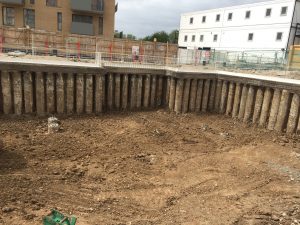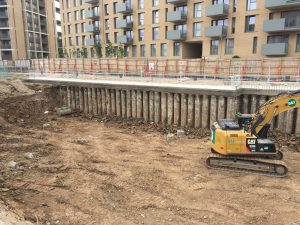Piled Retaining Walls
We can construct contiguous, secant or Kingpost walls using CFA and rotary bored or mini piling methods and therefore almost all ground conditions can be accommodated for permanent or temporary retaining walls. Bored pile walls are a very cost- effective means of retaining ground and can also be installed in restricted locations. Walls are normally formed utilising diameters of 450mm to 1200mm diameter dependent on the retained height and degree of temporary propping and soil conditions.
Contiguous piled wall: Contiguous piled walls are utilised in dry stable soils and where groundwater ingress is not an issue. The piles in these walls are installed at close centres with 150mm to 200mm intervening gaps between the outside faces of the piles. Following pile installation a reinforced concrete capping beam is installed connecting the piles together and these act together in supporting the required surcharge loads. Contiguous piled walls are less expensive and have a faster speed of installation when compared with secant piled walls.


Secant piled wall technique: Secant piled walls consist of a series of interlocking piles which can provide an impermeable piled wall thus retaining groundwater to the rear of the wall. In advance of piling, a temporary scalloped guide wall is installed along the line of the proposed wall in order to assist with pile positioning and alignment. Unreinforced primary piles are installed first using a lower initial strength concrete mix. Secondary piles are then installed between the primary piles, cutting into either side of the primary piles, then cast using a higher strength concrete mix with steel reinforcing. A pile capping beam links the top of the piles so that they act as a single element.
King Post wall technique: King post walls can provide a lower cost piled retaining wall solution for some projects. This technique is most suitable for above ground installation to provide earth retention for backfill placed to the rear of one side of the wall. Bored piled are first installed at pre-determined spacing, a steel H section is then fixed vertically into the pile. Timber sleepers or pre-cast concrete panels are then inserted between the steel H sections to complete the retaining wall.
